The Virtual PLC and Soft PLC Market is estimated to be valued at USD 1.1 billion in 2025 and is projected to reach USD 3.7 billion by 2035, registering a compound annual growth rate (CAGR) of 13.0% over the forecast period. Inflection point mapping reveals key transitions in market growth, highlighting periods of acceleration and stabilization. Between 2025 and 2030, the market grows from USD 1.1 billion to USD 2.0 billion, contributing USD 0.9 billion in growth, with a CAGR of 13.8%. This early-phase growth is driven by the increasing adoption of automation in industries such as manufacturing, automotive, and energy, as companies shift toward more flexible, scalable, and cost-effective control systems.
The market experiences its first inflection point around 2030, when it reaches USD 2.0 billion, signaling a shift towards more gradual growth. From 2030 to 2035, the market expands from USD 2.0 billion to USD 3.7 billion, adding USD 1.7 billion in growth, with a slightly higher CAGR of 14.3%. This phase reflects an acceleration in demand driven by the rise of smart manufacturing and Industry 4.0 technologies, as well as greater integration of IoT (Internet of Things) and cloud computing with PLC systems. The overall inflection point mapping shows a period of strong early acceleration, followed by continued growth driven by technological innovations and the increasing demand for flexible, software-based control systems.
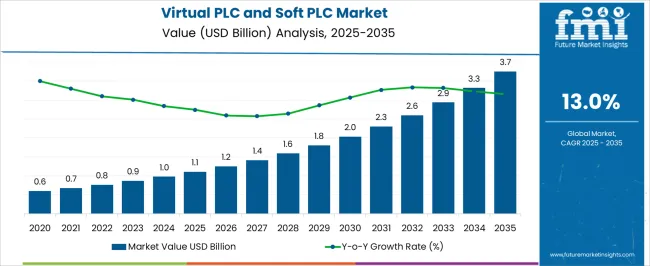
| Metric | Value |
|---|---|
| Virtual PLC and Soft PLC Market Estimated Value in (2025 E) | USD 1.1 billion |
| Virtual PLC and Soft PLC Market Forecast Value in (2035 F) | USD 3.7 billion |
| Forecast CAGR (2025 to 2035) | 13.0% |
The virtual PLC and soft PLC market is expanding rapidly as industries seek flexible and cost-effective automation solutions. Growing adoption of Industry 4.0 and digital transformation initiatives have propelled demand for software-based programmable logic controllers that offer adaptability and ease of integration.
Virtual PLCs eliminate the need for dedicated hardware, enabling control functions to run on general-purpose computers or embedded devices. This reduces setup costs and improves scalability for complex processes.
The trend toward smart manufacturing and real-time monitoring has increased reliance on soft PLCs for process optimization and remote management. Industries with intricate control requirements and a focus on operational efficiency are driving this market’s growth. Future demand is expected to be bolstered by advancements in software capabilities, edge computing, and enhanced cybersecurity measures. Segmental growth is expected to be led by Software components, Virtual PLC product types, and Process-level control applications due to their broad applicability and operational advantages.
The virtual PLC and soft PLC market is segmented by component, product type, control level type, deployment mode, operating system, communication protocol, application, and geographic regions. By component, the virtual PLC and soft PLC market is divided into Software, Virtual PLC Software, and Services. In terms of product type, the virtual PLC and soft PLC market is classified into Virtual PLC and Soft PLC. Based on the control level type of the virtual PLC and soft PLC market, it is segmented into Process level, Field level, Supervisory level, and Enterprise level. The virtual PLC and soft PLC market is segmented by deployment mode into On-premises and Cloud-based.
By operating system, the virtual PLC and soft PLC market is segmented into Windows-based, Linux-based, and Others. By communication protocol, the virtual PLC and soft PLC market is segmented into Ethernet/IP, Profinet, Modbus TCP, CANopen, and Others. By application, the virtual PLC and soft PLC market is segmented into Discrete manufacturing and Process manufacturing. Regionally, the virtual PLC and soft PLC industry is classified into North America, Latin America, Western Europe, Eastern Europe, Balkan & Baltic Countries, Russia & Belarus, Central Asia, East Asia, South Asia & Pacific, and the Middle East & Africa.

The Software component segment is projected to hold 38.4% of the market revenue in 2025, dominating due to its flexibility and lower capital expenditure compared to hardware components. Software-based PLCs facilitate easier updates and customization, which appeals to industries undergoing frequent process changes.
This segment benefits from growing trends in virtualization and cloud integration, allowing seamless upgrades and remote accessibility. Organizations prioritizing agile production environments prefer software PLCs for their ability to integrate with existing IT infrastructure.
As industrial automation evolves, the Software segment will likely maintain its significant market share by supporting scalable and efficient control solutions.

The Virtual PLC segment is expected to account for 53.7% of the market revenue in 2025, solidifying its position as the leading product type. Virtual PLCs offer the advantage of running control logic on standard computing platforms, which lowers installation and maintenance costs.
The segment’s growth is driven by industries that require flexible and modular automation systems, including batch processing and discrete manufacturing. Virtual PLCs provide enhanced connectivity and interoperability with other digital systems, facilitating Industry 4.0 objectives.
Their software-centric nature also enables faster deployment and integration with analytics and monitoring tools. As demand for intelligent and connected manufacturing systems increases, the Virtual PLC segment is projected to continue leading the market.
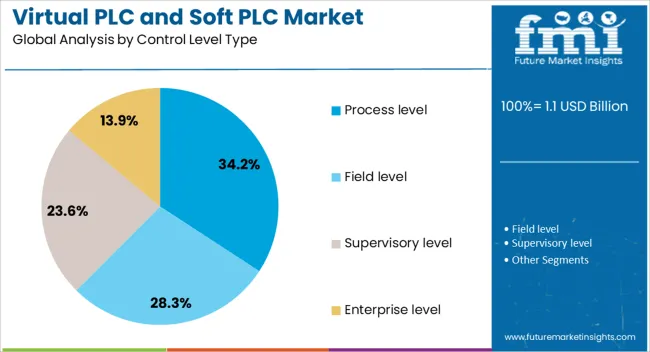
The Process Level control segment is projected to contribute 34.2% of the market revenue in 2025, standing as the most important control level type. This segment is critical in managing complex, continuous manufacturing processes that require precise monitoring and control of variables such as temperature, pressure and flow.
Process industries, including chemicals, pharmaceuticals, and oil and gas, have increasingly adopted soft and virtual PLCs to optimize operations and improve safety. The ability of process-level control systems to provide real-time feedback and integrate with supervisory control and data acquisition platforms enhances production efficiency.
As industries push for higher automation and tighter process control, the Process Level segment is expected to sustain its prominence in the market.
The virtual PLC and soft PLC market is expanding rapidly due to increasing adoption of automation systems across industries such as manufacturing, energy, and process control. Virtual PLCs and soft PLCs, which are software-based versions of traditional programmable logic controllers (PLCs), offer flexibility, scalability, and cost-efficiency in controlling industrial processes.
These systems allow for easier integration with IoT, cloud computing, and advanced analytics, driving demand for smart factory solutions. Despite challenges such as security concerns and initial setup complexity, advancements in software capabilities and increased focus on Industry 4.0 initiatives are fostering market growth.
The primary driver for the growth of the virtual PLC and soft PLC market is the increasing adoption of industrial automation solutions in manufacturing and other industries. As businesses strive to enhance operational efficiency and reduce downtime, PLCs have become essential in automating control systems. Virtual PLCs and soft PLCs, being software-based, offer greater flexibility and scalability compared to traditional hardware-based PLCs.
The rise of Industry 4.0, with its focus on connected devices, data analytics, and real-time decision-making, is driving demand for software-based PLC systems that can integrate seamlessly with IoT, cloud infrastructure, and advanced analytics platforms. This transition to digitalized, automated production processes is propelling the market's growth, as industries move toward smarter, more efficient systems.
A significant challenge in the virtual PLC and soft PLC market is the security risks associated with the increased digitalization of industrial control systems. As virtual and soft PLCs are software-based, they are more susceptible to cyber threats such as hacking, data breaches, and malware attacks. These risks can compromise operational integrity and safety in critical industrial processes.
Furthermore, integrating soft PLCs and virtual PLCs with legacy systems and diverse automation platforms can be complex. The transition from traditional hardware-based control systems to software-based solutions requires considerable expertise, training, and investment in new infrastructure, which can slow down adoption, particularly in industries that rely heavily on established systems.
The virtual PLC and soft PLC market presents significant opportunities, particularly with the integration of IoT and cloud-based solutions. As industries increasingly adopt IoT devices and platforms for remote monitoring and control, virtual PLCs offer enhanced connectivity and flexibility, enabling more intelligent automation systems. Soft PLCs can integrate seamlessly with cloud-based analytics platforms, allowing for real-time monitoring, predictive maintenance, and advanced data processing.
These capabilities open up new opportunities for industries such as energy, oil & gas, and manufacturing to enhance operational efficiency, reduce costs, and improve productivity. As businesses seek to optimize their supply chains and production systems, soft and virtual PLCs can provide a scalable solution to meet growing demands for flexibility and data-driven decision-making.
A key trend in the virtual PLC and soft PLC market is the growing adoption of Industry 4.0 technologies and edge computing. As manufacturers and other industries embrace smart factory concepts, the demand for real-time control, monitoring, and data processing is driving the need for advanced PLC solutions. Virtual PLCs and soft PLCs, integrated with edge computing, allow for faster processing of data at the point of origin, reducing latency and improving decision-making.
This trend is particularly important for industries requiring high-speed, mission-critical applications, such as automotive, food processing, and pharmaceuticals. The move towards Industry 4.0 also emphasizes the need for more connected, adaptive, and intelligent control systems, making virtual and soft PLCs a crucial part of the ongoing digital transformation in industrial operations.
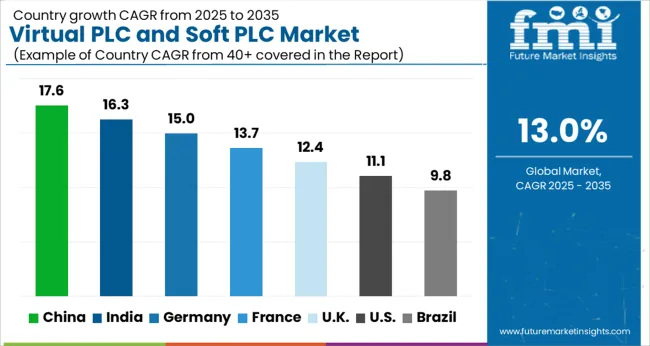
The Virtual PLC and Soft PLC market is projected to grow at a CAGR of 9.2% from 2025 to 2035. China leads the market with a growth rate of 17.6%, followed by India at 16.3% and France at 12.7%. The United Kingdom and the United States are growing at 11.5% and 10.3%, respectively. The market is driven by the increasing demand for automation, particularly in manufacturing, automotive, and energy sectors. As industries globally seek higher efficiency, reduced downtime, and cost savings, virtual PLC and soft PLC systems are becoming essential tools for digital transformation in manufacturing processes. The analysis includes over 40 countries, with the top countries detailed below.
China is expected to grow at a CAGR of 17.6% through 2035, driven by the country’s rapid industrialization and increasing focus on automation across various sectors. As the world’s largest manufacturing hub, China is experiencing a high demand for automation solutions like virtual PLC and soft PLC systems to enhance production efficiency, reduce downtime, and ensure safety. The government’s strong push towards smart manufacturing and the integration of IoT technologies are also contributing to the demand for these systems. With industries seeking advanced technologies to modernize their processes and improve productivity, the market for Virtual PLC and Soft PLC in China is set to experience substantial growth.
India is projected to grow at a CAGR of 16.3% through 2035. This growth is driven by the rapid expansion of industries such as manufacturing, automotive, and energy, all of which require advanced automation solutions like virtual PLC (Programmable Logic Controller) and soft PLC systems. India’s focus on modernizing its manufacturing sector, driven by government initiatives such as "Make in India," is further accelerating the demand for these solutions. The shift toward Industry 4.0 and digitalization is also contributing to the increasing adoption of soft PLCs in India. As industries embrace automation to improve efficiency and reduce operational costs, the demand for Virtual PLC and Soft PLC systems is expected to grow significantly.

Germany is projected to grow at a CAGR of 15.0% through 2035, supported by the country’s strong manufacturing and automotive sectors, both of which are increasingly adopting automation solutions. Germany is at the forefront of Industry 4.0 and is investing heavily in digital technologies, including virtual PLC and soft PLC systems, to enhance production processes, improve efficiency, and reduce costs. The country’s commitment to innovation, coupled with the growing trend of digitizing manufacturing processes, is boosting the demand for advanced automation solutions. As Germany continues to lead Europe in industrial automation, the market for virtual and soft PLC systems is set to grow significantly.
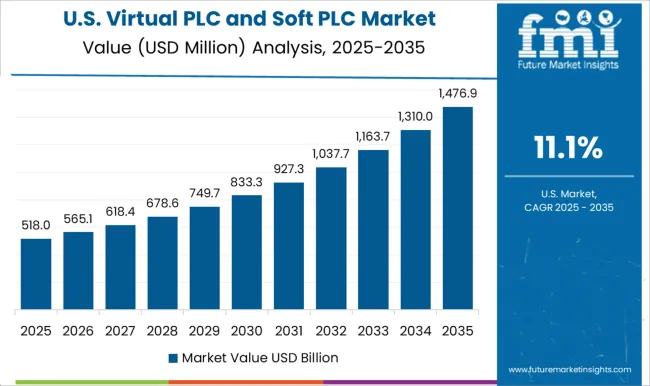
The United States is projected to grow at a CAGR of 11.1% through 2035, with increasing demand for advanced automation solutions across industries such as automotive, manufacturing, and energy. The USA is a leader in technology adoption and is rapidly moving towards Industry 4.0, which is driving the need for virtual PLC and soft PLC systems. These systems are being increasingly used to automate complex processes, improve efficiency, and minimize downtime in manufacturing operations. As the USA focuses on enhancing productivity and reducing operational costs, the market for Virtual PLC and Soft PLC systems is set to continue expanding.
The United Kingdom is expected to grow at a CAGR of 12.4% through 2035, driven by the increasing focus on automation and smart manufacturing. The UK is investing heavily in its industrial infrastructure, with industries such as automotive, energy, and manufacturing adopting more automated solutions like virtual PLC and soft PLC systems. As the country works towards Industry 4.0, the demand for these systems is growing to improve productivity, enhance safety, and reduce costs. The growing emphasis on reducing carbon footprints and improving operational efficiency across various industries is contributing to the demand for automation technologies in the UK
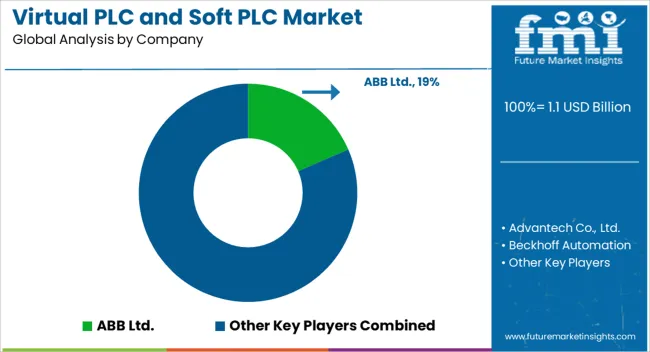
The Virtual PLC and Soft PLC market is defined by a small core of genuine software-runtime providers, surrounded by a wider orbit of hardware PLC brands that dabble in emulation or virtualization. The true production-grade vendors include Siemens (SIMATIC S7-1500V and Software Controller), Schneider Electric (EcoStruxure Automation Expert with Virtual PLC), Beckhoff (TwinCAT soft PLC on Windows PCs), B&R Industrial Automation (ABB) (PC-based Automation Runtime), Bosch Rexroth (ctrlX COREvirtual), CODESYS (3S-Smart Software Solutions) (the de facto soft PLC runtime), and Straton (STRATON® IEC 61131 runtime, widely embedded in OEM platforms).
Around these, companies like Phoenix Contact (PLCnext, PC WORX SRT), Pilz (psoft-PLC), WAGO (e!RUNTIME), COPA-DATA (zenon Logic), and Advantech (ProConOS/Multiprog SoftLogic) play niche but relevant roles, serving PC-based control adopters or specific industrial domains.
| Item | Value |
|---|---|
| Quantitative Units | USD 1.1 Billion |
| Component | Software, Virtual PLC Software, and Services |
| Product Type | Virtual PLC and Soft PLC |
| Control Level Type | Process level, Field level, Supervisory level, and Enterprise level |
| Deployment Mode | On-premises and Cloud-based |
| Operating System | Windows-based, Linux-based, and Others |
| Communication Protocol | Ethernet/IP, Profinet, Modbus TCP, CANopen, and Others |
| Application | Discrete manufacturing and Process manufacturing |
| Regions Covered | North America, Europe, Asia-Pacific, Latin America, Middle East & Africa |
| Country Covered | United States, Canada, Germany, France, United Kingdom, China, Japan, India, Brazil, South Africa |
| Key Companies Profiled | Siemens, Schneider Electric, Beckhoff, B&R Industrial Automation (ABB), Bosch Rexroth, CODESYS (3S-Smart Software Solutions), Straton, Phoenix Contact (PLCnext, PC WORX SRT), Pilz (psoft-PLC), WAGO (e!RUNTIME), COPA-DATA (zenon Logic), Advantech (ProConOS/Multiprog SoftLogic) |
| Additional Attributes | Dollar sales by product type (virtual PLC, soft PLC, hybrid PLC systems) and end-use segments (automotive, manufacturing, food and beverage, pharmaceuticals, packaging). Demand dynamics are influenced by the growing adoption of industrial automation, the shift towards smart factories, and the increasing need for real-time monitoring and control in manufacturing environments. Regional trends show strong growth in North America and Europe, where industrial automation and Industry 4.0 adoption are driving demand for soft PLC solutions, while Asia-Pacific is expanding rapidly due to increased manufacturing activities and the need for flexible automation solutions. |
The global virtual PLC and soft PLC market is estimated to be valued at USD 1.1 billion in 2025.
The market size for the virtual PLC and soft PLC market is projected to reach USD 3.7 billion by 2035.
The virtual PLC and soft PLC market is expected to grow at a 13.0% CAGR between 2025 and 2035.
The key product types in virtual PLC and soft PLC market are Siemens, Schneider Electric, Beckhoff, B&R Industrial Automation (ABB), Bosch Rexroth, CODESYS (3S-Smart Software Solutions), Straton, Phoenix Contact (PLCnext, PC WORX SRT), Pilz (psoft-PLC), WAGO (e!RUNTIME), COPA-DATA (zenon Logic), Advantech (ProConOS/Multiprog SoftLogic).
In terms of product type, virtual PLC segment to command 53.7% share in the virtual PLC and soft PLC market in 2025.






Our Research Products

The "Full Research Suite" delivers actionable market intel, deep dives on markets or technologies, so clients act faster, cut risk, and unlock growth.

The Leaderboard benchmarks and ranks top vendors, classifying them as Established Leaders, Leading Challengers, or Disruptors & Challengers.

Locates where complements amplify value and substitutes erode it, forecasting net impact by horizon

We deliver granular, decision-grade intel: market sizing, 5-year forecasts, pricing, adoption, usage, revenue, and operational KPIs—plus competitor tracking, regulation, and value chains—across 60 countries broadly.

Spot the shifts before they hit your P&L. We track inflection points, adoption curves, pricing moves, and ecosystem plays to show where demand is heading, why it is changing, and what to do next across high-growth markets and disruptive tech

Real-time reads of user behavior. We track shifting priorities, perceptions of today’s and next-gen services, and provider experience, then pace how fast tech moves from trial to adoption, blending buyer, consumer, and channel inputs with social signals (#WhySwitch, #UX).

Partner with our analyst team to build a custom report designed around your business priorities. From analysing market trends to assessing competitors or crafting bespoke datasets, we tailor insights to your needs.
Supplier Intelligence
Discovery & Profiling
Capacity & Footprint
Performance & Risk
Compliance & Governance
Commercial Readiness
Who Supplies Whom
Scorecards & Shortlists
Playbooks & Docs
Category Intelligence
Definition & Scope
Demand & Use Cases
Cost Drivers
Market Structure
Supply Chain Map
Trade & Policy
Operating Norms
Deliverables
Buyer Intelligence
Account Basics
Spend & Scope
Procurement Model
Vendor Requirements
Terms & Policies
Entry Strategy
Pain Points & Triggers
Outputs
Pricing Analysis
Benchmarks
Trends
Should-Cost
Indexation
Landed Cost
Commercial Terms
Deliverables
Brand Analysis
Positioning & Value Prop
Share & Presence
Customer Evidence
Go-to-Market
Digital & Reputation
Compliance & Trust
KPIs & Gaps
Outputs
Full Research Suite comprises of:
Market outlook & trends analysis
Interviews & case studies
Strategic recommendations
Vendor profiles & capabilities analysis
5-year forecasts
8 regions and 60+ country-level data splits
Market segment data splits
12 months of continuous data updates
DELIVERED AS:
PDF EXCEL ONLINE
PLC Controlled Packing Machine Market Trends – Forecast 2024-2034
G-3 PLC Solution Market – Smart Grids & Connectivity
Modular PLC Market
Micro and Nano PLC Market Trends - Growth & Forecast 2025 to 2035
SIL 2-Compliant PLCs Market Size and Share Forecast Outlook 2025 to 2035
Power Line Communication (PLC) Market Size and Share Forecast Outlook 2025 to 2035
Software Defined Networking (SDN) And Network Function Virtualization (NFV) Market Size and Share Forecast Outlook 2025 to 2035
Virtual Land NFT Market Size and Share Forecast Outlook 2025 to 2035
Software-Defined Wide Area Network Market Size and Share Forecast Outlook 2025 to 2035
Soft Start Resistor Market Size and Share Forecast Outlook 2025 to 2035
Soft Touch Lamination Film Market Size and Share Forecast Outlook 2025 to 2035
Virtual Pipeline Market Size and Share Forecast Outlook 2025 to 2035
Software Defined Vehicle Market Size and Share Forecast Outlook 2025 to 2035
Virtual Customer Premises Equipment Market Size and Share Forecast Outlook 2025 to 2035
Software Defined Perimeter (SDP) Market Size and Share Forecast Outlook 2025 to 2035
Virtual Infrastructure Manager Market Size and Share Forecast Outlook 2025 to 2035
Virtual Companion Care Market Size and Share Forecast Outlook 2025 to 2035
Soft Ferrite Core Market Size and Share Forecast Outlook 2025 to 2035
Virtualized Radio Access Network Market Size and Share Forecast Outlook 2025 to 2035
Soft Gripper Market Size and Share Forecast Outlook 2025 to 2035

Thank you!
You will receive an email from our Business Development Manager. Please be sure to check your SPAM/JUNK folder too.
Chat With
MaRIA